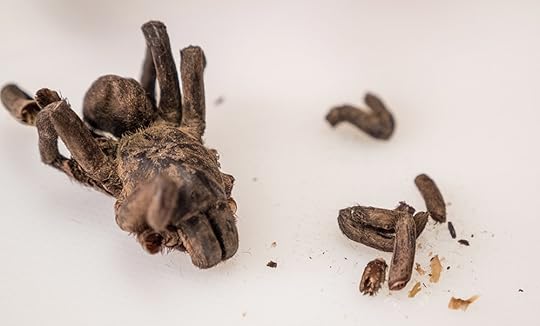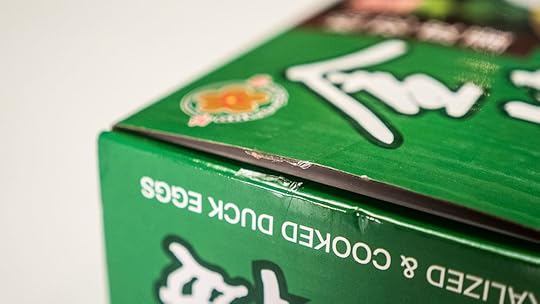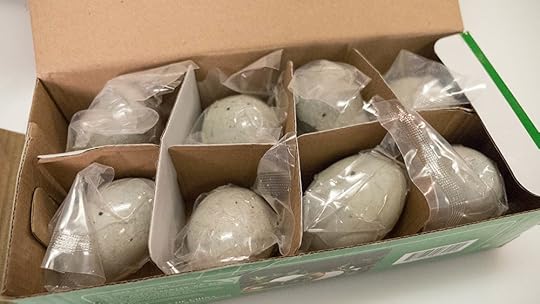Ripley Entertainment Inc.'s Blog, page 386
October 3, 2017
CARTOON 10-03-2017
October 2, 2017
Ripley’s Guide to Non-Perishables
Featured in Ripley's Believe It or Not!

Ripley’s Guide To
As the world ODDthority on all things unbelievable and weird, Ripley’s Believe It or Not! presents the mundane in a new light—seeking the strange in the everyday.
This is Ripley’s Guide To Non-Perishables.
The Weirdest Non-Perishables
Based in Orlando, Florida, we recently had to stock up on emergency supplies at our world headquarters, but soup and beans don’t cut it for the Ripley’s pantry. To find the oddest non-perishables we could, we scoured the internet and decided to taste test them for the prepper who wants their emergency meal to be strange and exciting.
Smoked Rattlesnake
In what the can claims is “True Rocky Mountain Style”, this can of allegedly smoked rattlesnake comes packed in water and brown sugar—not exactly the garnish you’d expect to eat snake from Colorado in.

Despite some slight rust around the bottom of the can, we decided to tuck in. What we didn’t anticipate was the sheer number of bones in a seven-ounce can. The warning on the side to “remove bones before sampling” is pretty misleading, as there was no way we could remove all the bones, no matter how sticky we were willing to get. One part of the warning was helpful though, as we did only “sample” our smoked snake.
“A True Western Delicacy!”

At the bottom of about two inches of syrupy water, a skeletal serpent clung to the little bit of meat it had left. We might have thought the snake inside was still alive—when our opener punctured the can, we were met with an audible hiss as air was sucked inside the broken seal. We truly wondered how we were supposed to eat this “Western Delicacy” because it was mostly water—holding true to the sloppy sounds the can made when you shook it.

The taste wasn’t that remarkable, just very salty. Though the meat looked like dark chicken meat, it tasted like canned ham. The brown sugar taste was absent, but there was some smoke in the aftertaste, though it was hard to tell if you were smelling it or tasting it.
Zebra Tarantula
After our sweet-tasting snake, we wanted something salty to clear our palates. Cooked and dehydrated zebra tarantula was our next snack. The can weighed almost nothing, and—if shaken—you could hear the spider pieces bouncing around inside. One plus for the spider is its pull-ring lid. The rattlesnake required a can-opener.

Zebra tarantulas are native to Central America and grow to about six inches across. The one in our can was probably just three inches. We’re guessing it didn’t live the full 20 years females in the wild do.
Though we appreciated the pop-top, we were surprised to see the spider was mostly whole. Wrapped in a hair-filled zip-lock bag, we slipped our fingers hoping it wasn’t just playing dead. The mandibles of the zebra tarantula were still scary up close, so we decided just to eat the legs. Though the can advertised it was dusted with salt, we all felt it could use more. The legs were too dry to have much taste, so you really had to take your time chewing them to coax out the flavor.

Century Eggs
These shelf-stable, alkalized and cooked duck eggs were probably the most curiously anticipated taste test at the office. Century eggs were traditionally soaked in alkaline clay, but now any number of methods are used to alkalize the eggs. As the caustic chemicals seep into the egg, the white turns brown, and the yolk turns a deep shade of green. Beautiful fern patterns etch themselves into the egg white as salt crystals form underneath the shell.

Historically eggs are coated in mud and rice husks to create a hard, dry crust, but ours came sealed in plastic. The box had clearly been opened before, with cut tape still intact, but someone deigned to stick a big piece of packing tape around the box to keep our eight eggs from spilling out.

Tape was cut on both sides before the eggs arrived.
There was a good mix of English and Chinese on the box, with text guaranteeing no refrigeration was need and that the eggs were “Ready to Eat.” Despite having the most suspect packaging, our century eggs were the only non-perishable we tested that included nutritional facts and contact information in case we needed more “safety information.” Each egg was individually wrapped in plastic, meaning you don’t have to eat eight green eggs at once if you’re hungry, but many of them were cracked.

The box directed us to peel and wash the eggs clean and add vinegar, soy sauce, and sesame oil to complete the flavor profile. Anticipating only eating these eggs in a survival situation, we eschewed these accouterments to taste the eggs simple and pure.

We cut into our eggs, and despite seeing runny yolks online—and on the box—ours were solid. The smell was really the worst part of these eggs. They reminded me of rotting clams or fishing bait. Once you got it in your mouth it pretty much tasted like a well salted boiled egg. The longer you chewed, the more time the heat of your mouth had to release the fishy flavor.

Verdict
The unanimous loser in our test was the smoked snake. The smell alone disqualified it from being dependable as a food source. There was too much liquid, too many bones, and not enough meat. That, combined with the need to have a can-opener, ranked the rattlesnake last, and other Amazon reviewers seem to agree.
Our middle pick was the zebra tarantula. We didn’t expect it to come whole, and despite being brave eaters found it to be a little difficult to swallow. If you’re like us and can only eat the legs, this also makes the tarantula the most expensive non-perishable on our list, though we do appreciate the pop-top lid. As one reviewer put it, if you’re into eating spiders, this is for you.

The century eggs were an absolute black-horse winner in our test. Nobody expected green eggs to be the most palatable ration in our lineup. Though the smell is bad, the taste is tolerable if you can eat it fast enough. We also think the nutritional content of the eggs makes for much heartier survival food than either of our other picks. As per tradition, we put whatever leftovers we didn’t want in the break room, where every unwanted item seems to find a home.

We tested these options, so you didn’t have to, but if you’re brave or curious enough to try these non-perishables yourselves, be sure to tell us what you think of them in the comments!
Try Century Eggs
Try Zebra Tarantula
Try Smoked Rattlesnake

Protected: Meet Ripley the Monkey–Yes, Named after Robert Ripley!
Featured in Ripley's Believe It or Not!

This content is password protected. To view it please enter your password below:
Password:
Source: Protected: Meet Ripley the Monkey–Yes, Named after Robert Ripley!
CARTOON 10-02-2017
October 1, 2017
CARTOON 10-01-2017
September 30, 2017
CARTOON 09-30-2017
September 29, 2017
A Dog Pays Cash for Treats and Melted Ice For Sale
Featured in Ripley's Believe It or Not!

[September 24-30, 2017] A hockey team sells melted ice, a monkey cares for its mummified daughter, and a clever dog learns it can pay cash for treats.
5. 4,000-Year-Old Decapitated Toad Collection
A research team led by the Israel Antiquities Authority recently excavated a 4,000-year-old tomb and made a strange discovery. They found a jar filled with decapitated toads. During this time in the area, people were interred with a “burial kit” which is meant to serve the dead in the afterlife. Researchers, however, are stumped as to what a bunch of headless toads was meant for in the afterlife.

4. Selling Melted Ice
The Detroit Red Wings hockey team has begun selling melted ice from its rink for $85 a vial. The melted ice—otherwise known as water—is being limited to just 3,000. The melted ice commemorates the stadium they’ve been in for 38 years as they move into their new home: Little Ceasar’s Arena.

3. Macaque Cares for Mummified Daughter
A mother macaque in the Parco Fuanistico dell’Abatino animal sanctuary in Italy was observed carrying around her mummified child for weeks. The child macaque died just four days after being born. As time went on, the remains dried out, eventually losing its fur and skin. Researchers have often observed primates caring for deceased young for a short time, but this macaque was also spotted eating the remains of its child in the third week. This behavior has never been observed before, and puzzles biologists, who point out that macaques are completely vegetarian.
Never-before-seen: Macaque mom ate the remains of her deceased infant https://t.co/dpiuexiQmT
— National Geographic (@NatGeo) September 26, 2017
2. Cone from Playset Removed after 40 Years
A man from Preston, England, inhaled a tiny toy traffic cone when he was just seven years old. When his doctor suspected he had a tumor 40 years later, they found the tiny plastic toy. The man admitted to regularly inhaling plastic toys as a kid and was not surprised at all. He suffered no ill effects for decades, and doctors think his throat was able to develop around the object as he grew.
BMJ journal report case of Preston man with suspected lung tumour. Turned out to be a toy traffic cone he’d ingested 40 years previously. pic.twitter.com/edk65W2dM1
— BBC North West (@BBCNWT) September 26, 2017
1. Dog Pays for Its Treats With Cash
Holly is a five-year-old dog with a sharp mind for finances. When she was a puppy, she would pull stuff out of her owner’s bag and run around the house. Instead of chasing her, owner Casi Cook bribed Holly with treats. This quickly reinforced the behavior that if Holly wanted treats, all she had to do was give her owner a dollar. Holly is now in love with money, receiving it as gifts from her owner, or just stealing it. Holly reportedly has $87 to her name and has even learned that she can’t use it for anything if it’s ripped.

Credit: Casi Cook
Eye-Socket Stretching Sideshow Sweeties: Captain and Maybelle
Featured in Ripley's Believe It or Not!

Chris and Elaine Steele, of Atlanta, Georgia, have been performing classic sideshow stunts as vaudeville couple Captain and Maybelle for over 17 years!
Their show includes a variety of feats, including eye-socket weight lifting, glass eating, fire breathing, human suspension, and of course, sword swallowing. A fixture during Ripley’s yearly World Sword Swallower’s Day festivities, Captain became the new record holder for “weighted sword swallowing” when he downed a 17-in (43-cm) blade with 84 lb (38 kg) of weights attached!
When I was young, I would go to the carnival, and I was fascinated with the entertainers, from fire breathers to sword swallowers. But I was more fascinated once I knew it was real, that it wasn’t an illusion. In my mind, if they could do it, I could do it. -Captain
Speaking of weights, Captain even uses his eye sockets to lift a bucket holding a 10 lb (4.5 kg) brick! If you think that’s impressive, watch Maybelle swallow and eat an entire balloon. This may be TMI, but she has proof that the balloons are completely digested…ew!
You can catch America’s favorite sideshow couple on YouTube, in Ripley’s Believe It or Not! Shatter Your Senses! and on tour around the country!








Source: Eye-Socket Stretching Sideshow Sweeties: Captain and Maybelle
CARTOON 09-29-2017
September 28, 2017
Or Not: The Dark Side of the Moon
Featured in Ripley's Believe It or Not!

Or Not
In today’s world many misconceptions have been perpetuated—becoming modern day “facts”—when, in reality, myths and hearsay have taken over. Sorry to burst your bubble, but in this weekly column, Ripley’s puts those delusions to the test, turning your world upside down, because you can’t always…Believe It!
Today: The Truth Behind the Dark Side of the Moon
The Dark Side of the Moon
The dark side of the moon just sounds eerie and almost mystical. What lies in the shadow of Earth’s lunar counterpart? What could be lurking in a veil of astral darkness, hidden from our sight for all of human history? UFO chasers and conspiracy theorists have long thought aliens or government secrets lurk just out of our sight in the black abyss.
Or Not
There is no more a dark side of the moon than there is a dark side of the Earth. Both celestial spheres rotate on an axis that gives equal amounts of sunlight to each side. The only disruption to this night-day pattern are eclipses, which only last for a short while.
While the moon orbits the Earth, it still rotates on its own axis, and actually rotates at a speed that keeps the same side facing Earth at all times.
The “dark side of the moon” perception is a confused interpretation of the same side of the moon always facing Earth. If you look into the sky from Earth you will see the same side of the moon that every other human has looked at since the beginning of time. It wasn’t until space travel that we were able to view the mysterious far side of the moon.

The far side of the moon, captured by NASA’s Lunar Reconnaissance Orbiter.
The Day the Moon Stood Still
The Moon wasn’t always locked in synchronized rotation with the Earth. As the moon formed 4.5 billion years ago, it did not rotate at the same speed as it orbited Earth.
The moon actually isn’t a perfect sphere. It’s bulged at the sides. Over the course of billions of years of the Earth’s gravitational forcing acting on the moon, these bulged portions aligned themselves with the Earth, creating the synchronized orbit we observe today.

The astronaut would continue to be visible as the moon orbited the earth.
Moon Myths
Despite the relatively simple explanation as to why a dark side of the moon doesn’t exist, conspiracists have long speculated as to what could be hiding on the far side of the moon.
Aliens are the most prevalent conspiracy theory about the moon’s fictional shadow. UFO hunters have long seen this as a perfect hiding spot for extra-terrestrials to study the Earth. Some theories go as far to say that Apollo astronauts made contact with these aliens, and have kept them a secret since the 1970s. This alien base was dubbed “Luna”.
The mysteries of the far side of the moon became central during the Cold War Conflict as well. The Pentagon opposed a Nuclear Test Ban Treaty on the grounds that the Soviets would simply test their weapons behind the moon. The USSR had no plans—or means—to test nuclear weapons beyond the moon, but it was later revealed that the US military had been planning to detonate a nuclear device on the moon as part of an experiment known as Project A119.
Ripley Entertainment Inc.'s Blog
- Ripley Entertainment Inc.'s profile
- 52 followers










